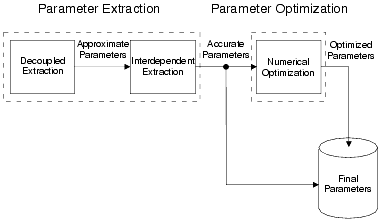Print version of this Book (PDF file)
Extraction Versus Optimization
IC-CAP makes a distinction between parameter extraction and parameter optimization. Parameter extraction (often used to refer generically to the process of obtaining model parameters) is defined more narrowly in the discussion of the IC-CAP system. Here, parameter extraction refers to the process of using device or circuit model specific algorithms to obtain model parameters directly from measured data. In contrast, parameter optimization is a general purpose, model independent process for numerically adjusting model parameter values. Parameter optimization keeps to a minimum some cost function (usually the difference between the model's simulated characteristics and the corresponding circuit measured characteristics).
The distinction between parameter extraction and optimization is an important concept to understand in discussing the IC-CAP methodology for extraction.
Global Optimization
A drawback to blind global optimization is that since the optimization routines know nothing about device physics or about the meaning of the model parameters, optimizing all of the model parameters to all of the measured data at once without any starting value determination often produces meaningless results. Also, global optimization consumes a great deal of computing power to analyze the myriad of possible parameter combinations without any model specific guidance. Many times, final parameter values are caught in local minima resulting in inaccurate values. Much time can be wasted attempting to optimize parameters to data on which they have no physical effect. Furthermore, parameters that have similar effects on the device characteristics (such as, RE and RB for the Bipolar model) are usually determined incorrectly. For these reasons, global optimization should not be performed in IC-CAP, although it can be done.
If global optimization is performed, Random or Hybrid (Random/LM) optimization should be used to avoid local minima. Random optimization can be used prior to Levenberg-Marquardt optimization to reduce the error to a reasonable starting value that is considered to be below that of any local minima. In Hybrid (Random/LM) optimization, random parameter jumps take place if the Levenberg-Marquardt optimizations are unsuccessful. When a local minimum is found, a random jump attempts to bypass it.
IC-CAP Extraction Methodology
The approach used in IC-CAP resolves the deficiencies of global optimization by using a parameter determination method. Specifically, any good parameter determination method must provide three very important things:
| • | Computational efficiency to minimize extraction run times |
| • | Device and circuit model specific knowledge inserted into the process for obtaining parameter values to ensure that meaningful parameter values result |
| • | Accuracy of the resulting parameters to ensure accurate circuit simulation even for analog designs |
Device or circuit operation is divided into several different regions. These regions are selected so that subsets of the model parameters have a clear effect on the model characteristics. This mapping of model parameter subsets onto regions of device operation where they have a dominant effect is referred to as an extraction strategy. Sensitivity analysis can be used as an aid in determining the proper regions. These regions of operation are predefined for the IC-CAP extraction Transforms. However, you may select these regions of operation for new or modified extractions. After the regions have been defined and the parameters with the greatest influence in those regions are selected, the actual parameter calculation process can begin.
Model Specific Extraction Routines
IC-CAP uses a 2-step model dependent parameter extraction process shown in the following figure.
Figure 30 IC-CAP Parameter Extraction Process
The purpose of parameter extraction is to obtain the most accurate model parameters possible directly from the measured data. The model-specific extraction algorithms solve the model equations in reverse. That is, given the measured electrical characteristics, the values of the model parameters that reproduce these characteristics must be determined. To accomplish this, a set of decoupled algorithms determine the initial values of the subset of the model parameters relevant in a given region. This decoupled extraction assumes no interaction between the model parameters and employs the use of curve fitting techniques.
To resolve the parameter interdependencies, an interdependent parameter extraction algorithm must be used. Iteration using model-specific equations is performed to balance the effects between interacting parameters.
The result of this 2-step process is a set of accurate parameters which can often be used without further modification in some applications.
Partial Optimization
The IC-CAP optimizer can fine tune extracted parameters. The optimization, known as partial optimization, is applied only to the parameters with dominant effects in a given region of operation. Since the initial values for the optimization now contain model specific information provided by the parameter extraction transforms, results from the optimization process are more accurate. Also, run time is minimized since the initial parameters are very close to the absolute minimum of the cost function represented by the difference between the measured and simulated data.
The optimizer is most effective when used in conjunction with model specific extraction transforms. However, several special features of the optimizer allow control of the solution in a manner that makes optimization starting from a less accurate initial value estimate feasible. The IC-CAP optimizer transform provides parameter constraints, data selection controls and convergence controls to tailor the optimizer's performance to the specific application. You can set these features in the optimizer transform editor.
